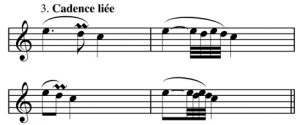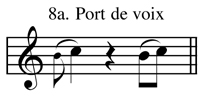Baroque Ornamentation I: Agréments
The few rules and examples given here represent the most common realizations of notational symbols for these graces, and the most common placements when no signs appear in the score. Thus, you will find brief descriptions of the ornaments, but also, a guide to choosing an appropriate ornamentwhen no sign appears in the written music.
The number of variant forms of each of these ornaments is legion, most fully described in Putnam Aldrich’s “The Principal Agréments of the Seventeenth and Eighteenth Centuries: A Study of Musical Ornamentation,” (PhD dissertation, Harvard University, 1942), which examines the subject both by ornament and by theorist. The precepts given by Aldrich have been summarized and passed on to me by my own teacher, himself a student of Aldrich, George Houle. Nothing this short can be comprehensive, but it should still provide a useful introduction to the subject for students and performers.
The term, “agréments,” by the way, means something like “things to make the music more agreeable.” It corresponds to the contemporary English term “graces,” which may be used instead.
Trill
(cadence or tremblement) consists basically of an indefinite number of alternations of the upper auxiliary and the written note (Ex. 1):
In performance it has three variable components:
1. Appuy: appoggiatura, or preparation (the note above the note that has the trill sign)
2. Battemens: beats, alternations, or repercussions of the two notes
3. Endings: consisting of three possibilities:
a) Liaison: where the note of resolution is preceded by an anticipation (Ex. 2a):
b) Tour de gosier: where a turn leads to the note of resolution (Ex 2b):
c) Point d’arrêt: where the trill stops on the written note before resolving directly (Ex 2c):
Methods of Performance of the Trill
1. Cadence apuyée: Preparation held about half the time (Ex. 2d):
2. Cadence subite: Preparation not held; beats begin immediately (as in Ex. 1):
3.Cadence liée: Tied trill — preceding note (M or m 2nd above) slurred to the trilled note, and in performance tied over into the beginning of the trilled note, so the appuy itself is not articulated (Ex. 3):
4. Cadence imparfaite: Short trill on rapid note (called imperfect because it lacks held preparation and ending). Four notes is enough (Ex. 4):
5. Cadence coulée: Trill with introductory turn (Ex. 5):
6. Double cadence: Trill at cadence extended backwards with a mordent and turn on the preceding dotted note. The sign-post is two consecutive dotted figures in the notation approaching a cadence. The three ornaments should be played without interruption (Ex. 6a & 6b):
Mordent
(Pincé or martellement) consists of alternation of written note and lower auxiliary, preferably a semitone. Usually, there are only one or two alternations (Ex. 7):
Port de Voix
is an ascending appoggiatura. It is frequently combined with a mordent (Ex. 8a & 8b):
Occasionally, the “double ascending appoggiatura” or Coulade is used when a note in a strong rhythmic position is approached by third from below. (Ex. 8c):
The Appoggiatura
is normally played on the beat. Its value depends on context but in the baroque era, usually takes half or even two-thirds of the value of the written note (Ex.9a):
One special form of the appoggiatura is known as the Coulé, namely one that fills in between descending thirds, either before the beat or on the beat (Ex.9b):
Tour de gosier
(turn, double) is an ornament that, in the baroque era, starts above the written note, moves through it, below then back to the written note (Ex. 10):

















